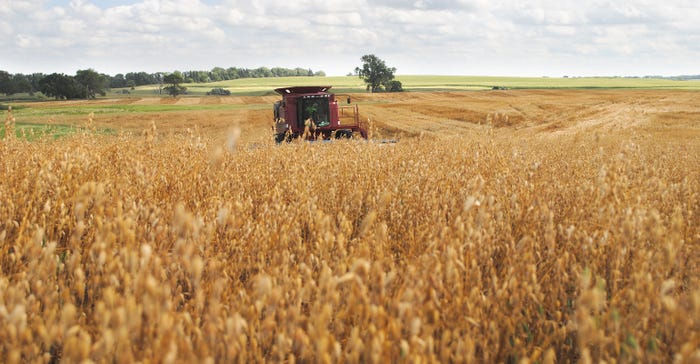
Lon Hall and his son, Jesse, Arlington, S.D., are all in on oats.
“We’ve made great strides and really bumped up yields in recent years,” says Lon Hall. “We would never have dreamed of 150-bushel-per-acre oats years ago, but now we can raise that kind of yield and get oats that have test weights between 40 and 45 pounds per bushel.”
When corn and soybean prices were high, there wasn’t much interest in oats. Acres were almost at historic lows. But since then, with lower corn prices and strong interest from millers in oats grown in the region, oat acres have nearly doubled. In South Dakota there were 310,000 acres planted to oats in 2016, compared to 160,000 in 2012. North Dakota farmers planted about 320,000 acres in 2016.
The Halls like the high yields they can get from the relatively low-input crop. High yields start with seed selection. Hall had a hand in developing many of the varieties available today. He was South Dakota State University’s oat project leader, oats breeder and principal investigator for oats research, dating back to his start initially as a technician in 1975. Over his last decade at SDSU, Hall worked with oat project technician Rachel Bauer on major crop improvements. Recently retired, Hall continues to grow oats on his farm with his son.

GOLDEN CROP: A high-yielding crop of oats is combined on the Hall farm in Brookings County.

“I would suggest looking at the SDSU yield trials and fungicide trials to see what works best,” Hall says.
Resistance to crown rust is crucial, he says.
“We go out in the field and scout for crown rust. It can really rob your yields, depending on the variety you planted.”
Hall recommends treating oats with fungicides such as Tilt and Stratego at full emergence of the flag leaf on susceptible oats to control crown rust. “I prefer to apply fungicides aerially because you get better plant coverage without leaving any tracks,” he adds.
Hall plants oats on silty loam and silty clay loam soils. “You have to be careful of planting on ground that has too high of fertility, like areas where you spread manure,” he says. “Variable-rate fertilizer applications can work for oats, fertilizing less on productive low ground and more on the less productive uplands” because lodging can be an issue on high-fertility soils.
Seeding rate can vary quite a bit. “We shoot for 28 pure live seeds per square foot, which can vary between 2 and 4 bushels per acre, depending on seed size,” Hall says.
The Halls use a Shelbourne Reynolds stripper header to harvest oats without swathing. “This header has stripping fingers that rotate and strip the grain off the stem, so you really can’t even tell that it has been harvested after combining,” Hall explains. “It works really well on lodged oats. The grain doesn’t shatter.”
The speed of the rotor fingers can be varied according to harvest conditions. The Halls will harvest oats that have a moisture content of up to 15%. They place the grain in an aeration bin to dry it down.
“Oats are a good crop in a three-way rotation with corn and soybeans,” Hall says. “Oats inhibit wireworms and promote mycorrhizae proliferation. You can often leave out some of the GMO traits in your other crops because oats helps to break disease and insect cycles,” he adds.
“Oats helps you to rotate modes of action on your pesticides, including fungicides. We don’t use seed treatments with oats because we haven’t seen a lot of data to support the practice,” says Hall.
Oats continues to be the focus of key studies at the SDSU Northeast Research Station, with current research focusing on the interactions of a growth regulator, variety selection and nitrogen fertility rates. “The only way for U.S. oats to compete is by maxing yields. However, increasing grain quality is an additional benefit of intense management,��” Hall says.
About the Author(s)
You May Also Like






